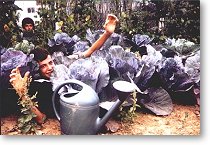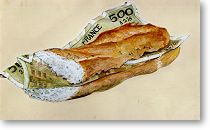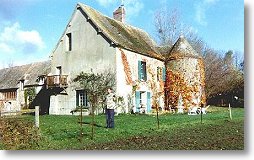For the amusements of my friends and family: A GROWER AND A SHOW-ER (Article-interview written by Stephen DiLauro, April 1999) Marcel likes to tell the story
of his great grandfather, an Alsatian officer in the
Prussian army. His job began when a village surrendered
to the army's advance. He would take over the parks,
castle gardens, private courtyards; anywhere food could
be grown. Then quickly plant potatoes and cabbages as
a hedge against winter famine. "I love that story",
he says.
Discovering a carrot row does better alongside a row of lettuce and that flowers are not only decorative, but insect repellant as well. This was the beginning of Marcel's art education. He has organized his gallery according to aesthetic principles learned in the garden. "I have not applied these lessons in all of my life", he says, explaining why he voluntarily cut short his higher academic education to get involved and learn more from the realities of the work place. He made it a point to explore with ravishment, all facets possible of various civil activities. From clerical work at the post office to hospital surgery blocks. Thanks to the wonderful French inclination to make almost everything a public service. One of his first jobs was working for the city government as a g-man (garbage man). He collected images of objects in evolution walking behind a garbage truck. He developed a hands-on sense of "The end of usefulness" and employs it in his art as a complement to the knowledge of gardening. Parisian galleries where then showing the "Accumulation" sculptures d'Arman and the compressions of Cesar. Not to forget Andy Warhol's suite of Marilyn Monroe serigraphs and various very determinant retrospectives. The works were displayed in the recently opened Paris Modern Art Center of Pompidou: Marcel Duchamps and Andre Breton, resonated in a well prepared retina. One can detect all these influences in the pronounced inclination Marcel has for painting series, declination, conjugation of themes. We can easily detect Magritte's influence, although Marcel does it less with the surrealism of the 40's and more with the political wit of British art-cartoonist Ronald Searles, who's drawings inspired much of Pierre's early work. ART EDUCATION The school systems of most countries profit from highly dedicated, enthusiastic art teachers. "I was married to Karen Mennes, not only was she a dedicated teacher, she was also a passionate artist. I learned a lot from her", says Marcel. Marcel feels he was well nurtured growing up in France. The abundance of museums and galleries there raised his willing mind to a level where participation became as necessary as appreciation. Being by chance in contact with a group of great French Artists, who have settled in Normandy, he learned the trade of serigraph printing and established a business. This allowed him to be part of the creative process. Meanwhile
he attended free adult evening classes at the Ecole Superieure
de Dessin de la Ville de Paris. "I appreciated the formal atmosphere
and was in need of the discipline at that time",
explains the artist.
At the end of this period of apprenticeship he joins long time friend and mentor Jacques Olivier in Miami Beach. Together they set up shop on Espanola Way in the Clay Hotel complex to start a decorative painting business. Subject To Change, Inc., a Florida corporation, is still thriving after 12 years, enriched by the partnership of New York muralist Frederic Lère, faux painter Luis Rodrigues and renowned Florida artist Mark Rutkowski. "Linda Polanski, my landlady, talked me into opening what was more our warehouse (initially), than a gallery to sell paintings. Over the years, she's really been more of a patron of the arts to us than a landlady." At the time Marcel was painting decorative murals in the homes of wealthy South Floridians. But these efforts did not necessarily satisfy the goals he was formulating for himself as an artist. In an effort to make art, which is involved in the community, its setting, landscape and preoccupations, Marcel began to approach his career with an attitude learned in the gardens of his youth. The former civil servant comes through offering affordable and non-elitist creations to the public. "When you grow a big cabbage or a beautiful basket full of strawberries, you show them off to your neighbors. You share the bounty. Sometimes... even, your neighbors might barter or buy what the garden produces." The big storefront window is often changing, always the presentation of some new fruit of artistic endeavor. "I don't have much appetite for catering exclusively to the very wealthy. I'm just as happy to have my prints displayed in a student's dorm-room or in a Jakarta office cubicle", he explains. With this in mind, and even more so on the World Wide Web, our planet has become his garden. The invitation is: To stop and enjoy an image as you might smell a rose or eat a peach. Gardening taught Pierre Marcel about the importance of beauty. This is perhaps the most elementary knowledge necessary to an artist. "I learned that a garden, which is pleasing to the eye, tends to grow better. This knowledge alone is the very foundation of the work I am doing now". Growing cabbage and roses in weed-ranked Normandy was where he learned that the essential reward is the passion one feels while working at something satisfying. Although Pierre has taken up residence in South Beach since 1986, he maintains close ties with his many friends in France. Recently, he installed a little art studio in Gisancourt, between Giverny and Gisors.
Check it out at 420 Espanola Way, Phone: 305-672-5305. In France, permanent exhibit at "Le Monarque" ,34 rue de Vienne, Gisors. |
||||||||
Home | Gallery | Lexicart | Biography | Murals | Prints | Guest-book | Contact


